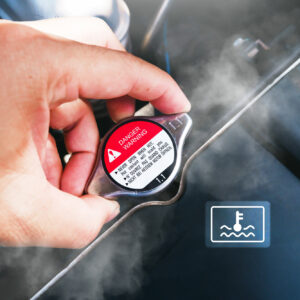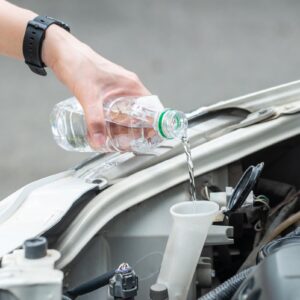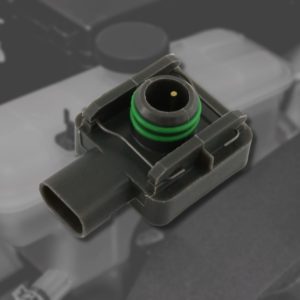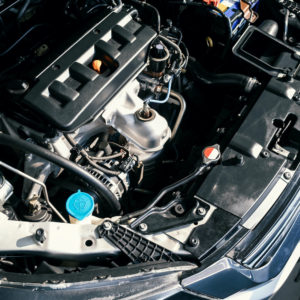Your vehicle’s coolant plays an important role in keeping your engine from overheating. It runs from the radiator to the engine and back again, transferring heat from the engine to the air using the principles of conduction and convection. The coolant absorbs the heat (mostly from the cylinder head but also from the cylinder walls), then carries it to the radiator’s thin tubes with their fins where the heat is removed from the coolant as the air passes through the radiator.
This process not only keeps the engine cool but, by way of the thermostat, it keeps the engine’s operating temperature up to a healthy average of 220 F, the temperature at which the engine runs most efficiently and with the least emissions. This is why it’s important to keep coolant topped up and flush it when needed.
How Often Should Coolant Be Flushed?
The general rule of thumb is to flush and replace your coolant every two years or every 30,000 miles–whichever comes first.
Manufacturers have different recommended mileage limits for coolants. These can fall anywhere from 30,000 to 150,000 miles depending on the type of coolant used and the design of the engine’s cooling system.

Make sure to check the coolant’s packaging and take note of when you need to have it flushed again. Take a look at your vehicle’s recommended coolant-change intervals as well.
Why Should You Flush Coolant?
Coolant is a mix of water and antifreeze with anticorrosive additives. The additives in common red and green antifreeze lose their anticorrosive properties after about two years.
This puts the metal parts of your vehicle’s cooling system in danger of rusting and suffering electrolysis if the coolant isn’t flushed and replaced.
Once rust and electrolysis set in, the damage that has already been done isn’t reversible. The best you can hope for is to remove the loose rust and replace components like the water pump, which may have suffered enough electrolysis cavitation so that the pump itself stops working efficiently, leading to a loss of cabin heat and eventual overheating.
Once rust and electrolysis set in, the damage that has already been done isn’t reversible. The best you can hope for is to remove the loose rust and replace components like the water pump, which may have suffered enough electrolysis cavitation so that the pump itself stops working efficiently, leading to a loss of cabin heat and eventual overheating.
–Richard McCuistian, ASE Certified Master Automobile Technician


Flushing also removes sediment and scale. This reduces corrosion and prevents radiator and heater core leaks. In addition, flushing helps with thermostat problems, overheating, and water pump failures.
Knowing When To Flush Your Coolant
If you’re unsure when your vehicle’s last coolant flush was, you can test the level of reserve alkalinity in the antifreeze. Reserve alkalinity test strips will tell you how much of this anticorrosive chemical is left in your system.
Too little of the chemical means it’s time for a flush. If the test is bad or close to the borderline, it’s best to replace your coolant as soon as possible.
When there’s too much water in your vehicle’s system, it might also be time for a flush or an antifreeze top-up. You can purchase test strips specifically to measure the strength of the coolant. Coolant strength is based on the ratio of coolant to water in your system. Monitoring the strength of your vehicle’s coolant minimizes the risk of your cooling system boiling over or freezing. Different types of antifreeze have different densities, so purchase strips that are compatible with the antifreeze in the system.
Can You Flush Your Own Coolant?
Flushing coolant used to be a fairly common DIY project. However, because cooling systems have become increasingly complex, it’s become more difficult. For a proper flush, you’ll need to remove at least 90% of the coolant, which can take a lot of time and effort. The risk of damaging your vehicle or not getting enough coolant out also increases. It’s best to bring the vehicle to a certified mechanic with a special drain and flush or a drain/flush/fill machine.
What Type of Coolant Should You Buy for a Flush?
Common coolants are dyed red and green, and orange. Modern cars can use these varieties according to the requirements of the car manufacturer, and provided a proper flush is performed before the replacement. Just be sure not to mix orange coolant with red and green coolant.

Coolant prices can go from $10 to $60 depending on the brand and formula.
Is There Such a Thing as Lifetime Coolant?
You might notice that certain coolants have the words “extended life” on their packaging. Different formulas can affect your coolant’s lifespan, but keep in mind that there’s no such thing as a lifetime coolant. You still need to follow the manufacturer’s guidelines to know how often you should flush your coolant.
Can You Extend or Reduce Coolant Life?
The calculations for coolant life depend a lot on the antifreeze-to-water ratios. Most of the time, these calculations are based on a 50/50 ratio. Ratios for coolants can vary between climates. Some areas with colder temperatures require higher antifreeze concentrations to prevent coolant lines from freezing.
These situations inevitably affect coolant life. A larger water-to-antifreeze ratio can lead to rapid system corrosion much earlier than a typical 50/50 ratio. Having low coolant levels for too long also causes this problem due to the air bubbles in the system.
As a rule, keep your coolant levels topped up with a ratio suitable to your climate. Even if there’s a higher ratio of antifreeze in the system, follow the manufacturer’s directions when scheduling a flush. If there’s a higher ratio of water or the coolant has been sitting, it might be time for an early flush and top-up.
You can watch this video to get an idea how to change your coolant:
Getting New Coolant for Your Vehicle
Topping up or flushing your coolant can’t wait. The longer you put it off, the more you risk damaging your engine. After around two years, coolant is likely to lose its anticorrosive properties, leaving your cooling system prone to rust. If you want to save your cooling system from corrosion, you should top up or flush your coolant following your vehicle’s maintenance schedule. Luckily, getting new coolant is fast and easy with CarParts.com.
CarParts.com offers a wide selection of antifreeze that’s sourced from only the most trusted manufacturers in the industry. Easily browse through our catalog with the help of our vehicle selector and search filters. Just enter your vehicle’s correct details, and you can easily see the coolants that are compatible with your ride. Thanks to our strategically located warehouses around the US, CarParts.com also guarantees fast shipping. Order by 12 PM ET, and you can expect your new coolant to arrive in as fast as two business days.
Don’t wait for your old coolant to damage your radiator and heater core before replacing it. Check out our catalog of high-quality antifreeze at CarParts.com and order today!
Any information provided on this Website is for informational purposes only and is not intended to replace consultation with a professional mechanic. The accuracy and timeliness of the information may change from the time of publication.































Another very informative article by Richard McCuistian.
Thank you for the picture of the “orange sludge”. I wouldn’t have believed it, if I didn’t see it. What a mess to clean out.
It’s worth noting that in order to always maintain the optimum 50/50 blend of antifreeze/water, people can simply buy the ready-to-use pre-mixed coolant and keep an extra jug on hand, to add when needed, rather than adding water to the system and diluting the solution.
Adding only premixed coolant, also eliminates calcium, magnesium and other salts that come with hard water from the tap. Although, it is recommended to only add distilled water, I wonder how many people actually take that effort.